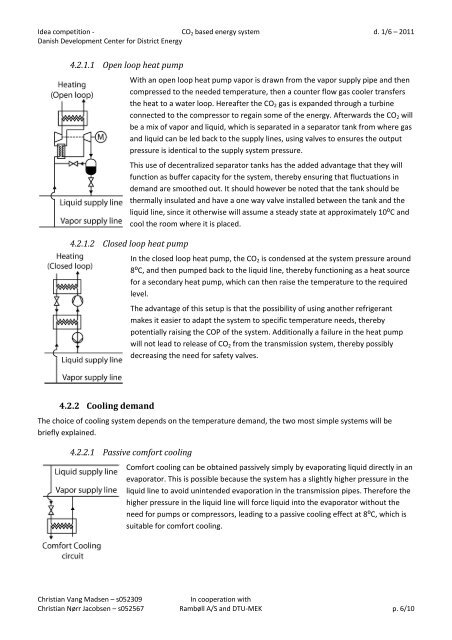Danish Development Center for District Energy CO2 based district ...
Danish Development Center for District Energy CO2 based district ...
Danish Development Center for District Energy CO2 based district ...
- No tags were found...
You also want an ePaper? Increase the reach of your titles
YUMPU automatically turns print PDFs into web optimized ePapers that Google loves.
Idea competition ‐ CO 2 <strong>based</strong> energy system d. 1/6 – 2011<strong>Danish</strong> <strong>Development</strong> <strong>Center</strong> <strong>for</strong> <strong>District</strong> <strong>Energy</strong>4.2.1.1 Open loop heat pumpWith an open loop heat pump vapor is drawn from the vapor supply pipe and thencompressed to the needed temperature, then a counter flow gas cooler transfersthe heat to a water loop. Hereafter the CO 2 gas is expanded through a turbineconnected to the compressor to regain some of the energy. Afterwards the CO 2 willbe a mix of vapor and liquid, which is separated in a separator tank from where gasand liquid can be led back to the supply lines, using valves to ensures the outputpressure is identical to the supply system pressure.This use of decentralized separator tanks has the added advantage that they willfunction as buffer capacity <strong>for</strong> the system, thereby ensuring that fluctuations indemand are smoothed out. It should however be noted that the tank should bethermally insulated and have a one way valve installed between the tank and theliquid line, since it otherwise will assume a steady state at approximately 10⁰C andcool the room where it is placed.4.2.1.2 Closed loop heat pumpIn the closed loop heat pump, the CO 2 is condensed at the system pressure around8⁰C, and then pumped back to the liquid line, thereby functioning as a heat source<strong>for</strong> a secondary heat pump, which can then raise the temperature to the requiredlevel.The advantage of this setup is that the possibility of using another refrigerantmakes it easier to adapt the system to specific temperature needs, therebypotentially raising the COP of the system. Additionally a failure in the heat pumpwill not lead to release of CO 2 from the transmission system, thereby possiblydecreasing the need <strong>for</strong> safety valves.4.2.2 Cooling demandThe choice of cooling system depends on the temperature demand, the two most simple systems will bebriefly explained.4.2.2.1 Passive com<strong>for</strong>t coolingCom<strong>for</strong>t cooling can be obtained passively simply by evaporating liquid directly in anevaporator. This is possible because the system has a slightly higher pressure in theliquid line to avoid unintended evaporation in the transmission pipes. There<strong>for</strong>e thehigher pressure in the liquid line will <strong>for</strong>ce liquid into the evaporator without theneed <strong>for</strong> pumps or compressors, leading to a passive cooling effect at 8⁰C, which issuitable <strong>for</strong> com<strong>for</strong>t cooling.Christian Vang Madsen – s052309In cooperation withChristian Nørr Jacobsen – s052567 Rambøll A/S and DTU‐MEK p. 6/10
















